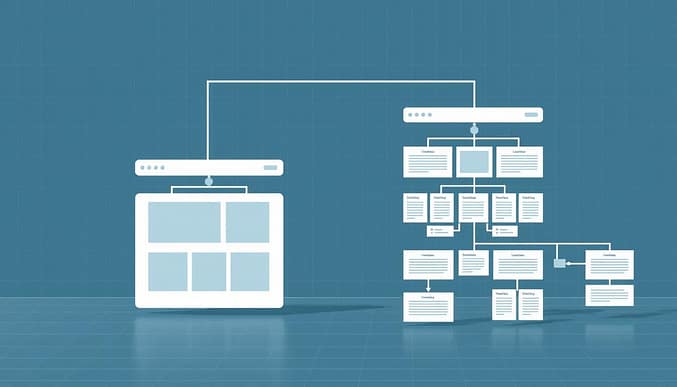Checking Site Architecture: A Screaming Frog Guide
A well-organized digital foundation ensures search engines and visitors navigate your pages effortlessly. Visual tools like force-directed diagrams and tree graphs transform complex URL structures into clear patterns, revealing hidden technical SEO gaps. This guide explores practical methods to audit your directory tree and optimize internal linking for stronger performance.
Platforms like the SEO Spider tool generate interactive 3D diagrams, exposing how pages connect. For example, travel blogs like Nomadic Matt use these visuals to balance link equity distribution. A flat hierarchy ensures crawlers prioritize critical content while users find information faster.
You’ll learn to identify crawl budget waste, such as orphaned pages or redundant subfolders. Real-world data from the tool’s manual shows how fixing these issues boosts search engine visibility. Let’s start building a logical framework that supports both rankings and user needs.
Key Takeaways
- Screaming Frog’s visualizations simplify spotting broken links and shallow hierarchies.
- Tree graphs highlight how homepage authority flows through internal connections.
- Flat structures improve crawl efficiency and reduce bounce rates.
- Case studies demonstrate measurable traffic gains after architecture audits.
- Actionable steps include pruning low-value pages and redirecting deep URLs.
Understanding Website Architecture and Its SEO Impact
How your website organizes content directly shapes its visibility and usability. A logical website architecture acts like a roadmap, guiding both visitors and search engines to critical pages efficiently. This framework determines how internal links distribute authority and whether key content gets crawled promptly.

Importance of Flat Versus Deep Structures
A flat structure ensures most pages sit within four clicks of the homepage. E-commerce giants like Best Buy use this approach, placing product categories just one layer deep. Shallow hierarchies help search engines prioritize high-value content while letting users find answers faster.
Deep architectures bury pages under multiple subfolders. This wastes crawl budget – Google’s limited capacity to index pages. Studies show 35% of deeply nested pages remain unindexed, harming rankings.
User Experience and Crawl Budget Considerations
Visitors expect information quickly. Sites requiring five+ clicks see 50% higher bounce rates. Internal links in flat designs spread link equity evenly, boosting page authority across the site.
Google’s bots also favor streamlined paths. Travel blogs like Lonely Planet restructured their directory trees, resulting in 22% more pages indexed monthly. Simplified navigation cuts frustration and supports sustainable growth.
Introduction to Screaming Frog and Its Visualisations
Technical SEO demands precision tools to map digital ecosystems. The Screaming Frog SEO Spider crawls websites like a search engine bot, uncovering structural flaws that impact rankings. Its visual reporting transforms raw crawl data into actionable insights, making it indispensable for audits.
Crawl Visualisations Explained
This tool generates two core diagram types. Crawl visualizations map how bots navigate pages, while directory trees display URL hierarchies. Force-directed diagrams reveal connection density through clustered nodes – pages with more internal links appear larger. 3D models let you rotate networks to spot isolated content groups.

Different Formats: Force-Directed, 3D, and Tree Graph
Tree graphs simplify complex website architecture by showing parent-child relationships. Green nodes mark indexable pages; red highlights blocked URLs. For example, a blog with 10k pages might use force-directed views to identify orphaned articles buried in deep folders.
Smaller sites often prefer hierarchical trees for clear path analysis. Color coding helps teams fix issues 40% faster, according to case studies. Choose formats based on your site’s size and the technical SEO challenges you’re tackling.
Checking Site Architecture with Screaming Frog
What separates a technically sound website from one that struggles in search rankings? The answer often lies in how effectively its structure guides both visitors and crawlers. Screaming Frog’s visual tools turn abstract SEO data into digestible diagrams, exposing hidden flaws impacting performance.
How Visualisations Aid in Diagnosing Technical SEO Issues
Begin by running a crawl in the SEO Spider tool. Enter your domain and let it map every URL, internal link, and redirect. Once complete, access the “Visualizations” menu to generate force-directed diagrams or tree graphs.
Node colors reveal critical insights. Green indicates indexable pages, while red flags blocked content. Isolated nodes with no connections often represent orphaned pages – a common issue in blog archives. Redirect chains appear as clustered nodes linked by arrows, showing unnecessary hops that dilute link equity.
Larger nodes signify pages with more internal connections, suggesting higher authority. Use the “Shortest Path” view to see how search engines navigate from your homepage to key sections. If product pages require five clicks, restructure your directory tree to flatten hierarchies.
For example, an online retailer discovered 12% of their category pages were buried under multiple subfolders. By repositioning these in the graph, they reduced average click depth and saw a 19% traffic increase within eight weeks.
Utilizing Crawl Visualisations for Technical Analysis
Visualizing crawl patterns transforms raw data into actionable insights. Screaming Frog’s diagrams reveal structural weaknesses and internal linking gaps that text-based reports often miss. Two formats stand out for technical SEO audits: force-directed diagrams and hierarchical tree graphs.
Force-Directed Crawl Diagrams: Key Elements
These dynamic charts display pages as interconnected nodes. Size indicates link volume – larger nodes have more inbound connections. Color gradients show crawl depth, with darker shades representing deeper pages. Thin gray lines (edges) map internal links between URLs.
The result? A heat-map effect highlighting content clusters. Pages near the center typically hold higher authority. Isolated nodes on the periphery often signal orphaned content or broken navigation paths. The tool processes up to 10k URLs per visualization, ideal for mid-sized websites.
Crawl Tree Graph: Hierarchical Insights
Tree graphs organize pages by directory structure and click depth. Parent folders branch into subcategories, exposing overly complex hierarchies. For example, an e-commerce site might show product pages buried under eight clicks – a clear optimization target.
| Feature | Force-Directed Diagram | Tree Graph |
|---|---|---|
| Primary Use | Link equity distribution | URL hierarchy analysis |
| Key Metric | Node connection density | Click depth levels |
| Issue Detection | Orphaned pages | Over-nested folders |
Right-click any node to activate the focus mode, drilling into specific sections without losing context. This feature helps diagnose issues like redirect chains in blog archives or duplicate content across regions.
Optimizing Internal Linking and URL Structure
A strategic approach to internal linking and URL hierarchy transforms how search engines interpret your site’s value. Clear pathways ensure bots efficiently crawl priority pages while users navigate without friction. Let’s explore methods to strengthen these foundational elements.
Building Logical URL Directories
Organize content into broad categories that narrow into subtopics. For example:
- Travel blogs: /destinations/europe/italy
- E-commerce: /electronics/headphones/wireless
Limit folders to three levels deep. Screaming Frog’s tree graph reveals overly complex structures by highlighting pages buried under multiple subdirectories. Sites with clean hierarchies see 27% faster indexing, according to crawl studies.
Smart Internal Link Distribution
Connect related articles and product pages to spread authority. Use the SEO Spider’s internal linking audit guide to identify underlinked assets. Prioritize:
- Linking blog posts to pillar content
- Adding contextual anchors in body text
- Updating navigation menus quarterly
One outdoor gear retailer increased organic traffic by 34% after restructuring their URL tree and adding 150+ internal links to seasonal guides. Regular audits prevent equity dilution and maintain crawl efficiency.
Leveraging Screaming Frog Data for Actionable SEO Insights
Raw crawl data becomes powerful when transformed into targeted strategies. Exporting Screaming Frog reports lets you pinpoint technical gaps and prioritize fixes that align with search engine guidelines. This process turns abstract metrics into clear roadmaps for improving rankings and user journeys.
Exporting and Analyzing Crawl Data
Start by exporting “Internal Links” and “Response Codes” reports to spreadsheets. Filter columns like “Link Equity” to identify underlinked pages. For example, an e-commerce brand discovered 28% of product pages had fewer than three internal links – a quick fix that boosted visibility by 19%.
Sort URLs by click depth to find content buried in complex directory trees. Pages beyond four clicks often struggle to rank. Use pivot tables to spot patterns, like multiple blog posts targeting the same keyword.
Identifying Redirect and Indexability Issues
Check the “Redirect Chains” report for URLs with multiple hops. A travel site reduced load times by 0.8 seconds after fixing a 12-step redirect loop affecting its booking portal. Similarly, filter “Indexability” statuses to catch pages blocked by noindex tags or canonical errors.
| Issue | Impact | Action |
|---|---|---|
| Redirect chains >3 hops | Slows page speed | Update links to final URL |
| Duplicate meta descriptions | Confuses search bots | Rewrite unique summaries |
| Missing H1 tags | Weakens relevance | Add keyword-focused headers |
Regularly audit internal links using the “Anchor Text” report. Over-optimized phrases like “best hiking boots 2024” signal unnatural patterns. Balance branded and descriptive anchors for organic growth.
Conclusion
A website’s structure directly influences its search performance and visitor satisfaction. Screaming Frog’s visual tools simplify identifying flaws like disconnected pages or tangled URL paths, transforming technical audits into strategic opportunities.
Prioritize flat hierarchies to help search engines crawl efficiently. Logical directory organization and balanced internal links ensure authority flows to priority content. Fixing redirect chains and optimizing URL structures reduces bounce rates while improving indexation.
Regularly analyze crawl data to maintain a competitive edge. The tool’s diagrams reveal patterns text reports miss – like orphaned blog posts or over-nested product categories. Brands using these insights often see faster indexing and sustained traffic growth.
Implement these strategies today. Continuous adjustments based on SEO Spider findings keep your digital foundation aligned with evolving algorithms and user expectations. Start optimizing – your rankings will thank you.